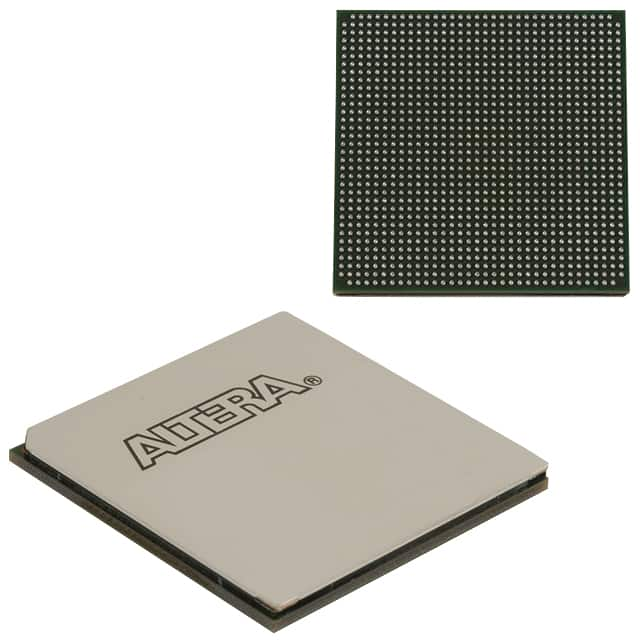EP4SGX230HF35C3N
Product Overview
- Category: Field Programmable Gate Array (FPGA)
- Use: EP4SGX230HF35C3N is a high-performance FPGA designed for various applications in industries such as telecommunications, automotive, aerospace, and consumer electronics.
- Characteristics: This FPGA offers advanced features including high-speed performance, low power consumption, and flexible programmability. It provides a wide range of resources such as logic elements, memory blocks, and digital signal processing (DSP) blocks.
- Package: EP4SGX230HF35C3N comes in a compact and durable package suitable for surface mount technology (SMT) assembly.
- Essence: The essence of EP4SGX230HF35C3N lies in its ability to provide a customizable hardware platform that can be programmed to perform specific functions according to the user's requirements.
- Packaging/Quantity: EP4SGX230HF35C3N is typically packaged in trays or reels and is available in various quantities depending on the customer's needs.
Specifications
- Logic Elements: 230,000
- Memory Blocks: 5,760
- Digital Signal Processing (DSP) Blocks: 960
- Embedded Multipliers: 1,920
- I/O Pins: 622
- Operating Voltage: 1.2V
- Operating Temperature Range: -40°C to 100°C
- Package Type: F35 (35mm x 35mm)
Detailed Pin Configuration
The EP4SGX230HF35C3N FPGA has a complex pin configuration with multiple I/O banks and dedicated pins for various functions. For detailed pin configuration information, please refer to the manufacturer's datasheet.
Functional Features
- High-speed performance: EP4SGX230HF35C3N offers fast data processing capabilities, making it suitable for applications that require real-time processing.
- Low power consumption: This FPGA is designed to optimize power efficiency, enabling longer battery life in portable devices and reducing energy consumption in larger systems.
- Flexible programmability: EP4SGX230HF35C3N can be programmed and reprogrammed to adapt to changing requirements, allowing for easy customization and updates.
- Abundant resources: With a large number of logic elements, memory blocks, DSP blocks, and embedded multipliers, this FPGA provides ample resources for complex designs.
Advantages and Disadvantages
Advantages: - High-performance capabilities - Low power consumption - Flexible programmability - Abundant resources for complex designs
Disadvantages: - Complex pin configuration may require careful planning and design considerations - Higher cost compared to simpler programmable logic devices
Working Principles
EP4SGX230HF35C3N operates based on the principles of digital logic. It consists of configurable logic blocks (CLBs), interconnects, and various specialized components such as memory blocks and DSP blocks. The CLBs can be programmed to implement specific logic functions, while the interconnects provide the necessary connections between different components. By configuring the FPGA using a hardware description language (HDL), users can define the desired functionality of the device.
Detailed Application Field Plans
EP4SGX230HF35C3N finds applications in various industries and domains, including:
- Telecommunications: Used in high-speed data communication systems, network routers, and switches.
- Automotive: Employed in advanced driver-assistance systems (ADAS), infotainment systems, and engine control units (ECUs).
- Aerospace: Utilized in satellite communication systems, avionics, and flight control systems.
- Consumer Electronics: Integrated into high-definition televisions, gaming consoles, and multimedia devices.
Detailed and Complete Alternative Models
- EP4SGX180HF35C3N: A lower-cost alternative with slightly reduced resources but similar performance characteristics.
- EP4SGX280HF35C3N: A higher-end model with increased logic elements and memory blocks for more demanding applications.
- EP4SGX230HF40C3N: A variant with a higher operating temperature range suitable for extreme environments.
These alternative models provide options for different project requirements and budgets while maintaining compatibility with the EP4SGX230HF35C3N in terms of functionality and programming.
Word count: 536 words
قم بإدراج 10 أسئلة وإجابات شائعة تتعلق بتطبيق EP4SGX230HF35C3N في الحلول التقنية
Sure! Here are 10 common questions and answers related to the application of EP4SGX230HF35C3N in technical solutions:
Q: What is EP4SGX230HF35C3N? A: EP4SGX230HF35C3N is a specific model of Field-Programmable Gate Array (FPGA) manufactured by Intel.
Q: What are the key features of EP4SGX230HF35C3N? A: EP4SGX230HF35C3N offers high-density programmable logic, high-speed transceivers, embedded memory blocks, and various I/O interfaces.
Q: In what technical solutions can EP4SGX230HF35C3N be used? A: EP4SGX230HF35C3N can be used in a wide range of applications such as telecommunications, networking, industrial automation, aerospace, and defense.
Q: How does EP4SGX230HF35C3N contribute to telecommunications solutions? A: EP4SGX230HF35C3N enables the implementation of advanced signal processing algorithms, high-speed data transmission, and efficient network protocols in telecommunications systems.
Q: Can EP4SGX230HF35C3N be used for image and video processing applications? A: Yes, EP4SGX230HF35C3N's high-performance capabilities make it suitable for image and video processing tasks, including real-time video streaming, image recognition, and computer vision.
Q: What advantages does EP4SGX230HF35C3N offer in industrial automation? A: EP4SGX230HF35C3N provides flexible and customizable solutions for control systems, robotics, motion control, and sensor integration in industrial automation.
Q: How does EP4SGX230HF35C3N support aerospace applications? A: EP4SGX230HF35C3N's high reliability, radiation tolerance, and ability to handle complex algorithms make it suitable for aerospace systems such as satellite communication, avionics, and navigation.
Q: Can EP4SGX230HF35C3N be used in defense applications? A: Yes, EP4SGX230HF35C3N is commonly used in defense systems for tasks like secure communications, radar processing, encryption, and missile guidance.
Q: What are the power requirements for EP4SGX230HF35C3N? A: EP4SGX230HF35C3N typically operates at a voltage range of 1.2V to 1.5V, with power consumption varying based on the specific design and utilization.
Q: Are there any development tools available for programming EP4SGX230HF35C3N? A: Yes, Intel provides Quartus Prime software suite, which includes design entry, synthesis, simulation, and programming tools specifically tailored for programming EP4SGX230HF35C3N.
Please note that these answers are general and may vary depending on the specific requirements and use cases of EP4SGX230HF35C3N in different technical solutions.


